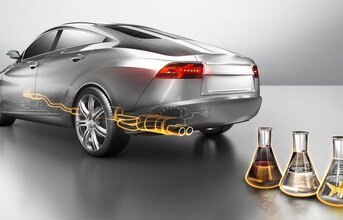
It also enables anticipatory heating for predictive drive strategies. "In hybrid vehicles, it is particularly important to understand the system as a whole with regard to the combustion engine and the electric motor," explains Distelhoff.
Quality of urea vaporisation in the SCR assembly
For efficient catalytic reduction of NOx, the procedure with which a diluted urea solution ("AdBlue") is injected as a reducing agent into the exhaust gas is crucial. In order to achieve conversion rates of 98 per cent and higher, the measurement and vaporization processes must be extremely precise.
The standard systems today have a minimum distance of around 300 mm for injection in the direction of the exhaust flow and subsequent vaporisation of the urea solution into a gaseous phase.
But this distance is difficult to achieve with a close-coupled design. Continental has therefore developed a system that injects the urea solution in the direction opposite to the exhaust flow. The solution is sprayed on a structure with a hydrolytic coating on the back of the catalytic converter. "This compact design also enables close-coupled systems for SCR exhaust aftertreatment," says Dr. Distelhoff.
Together with Continental's reducing-agent injectors, the counter-flow injection system prevents urea sedimentation and ammonia slip, as well as a lack of reducing agents in the exhaust flow, even in highly compact designs. For precise control of exhaust after treatment, Continental supplies sensors such as the Urea Level and Concentration, the NOx, as well as the High Temperature sensors.
Continental develops intelligent technologies for transporting people and their goods. As a reliable partner, the international automotive supplier, tire manufacturer, and industrial partner provides sustainable, safe, comfortable, individual, and affordable solutions.



























